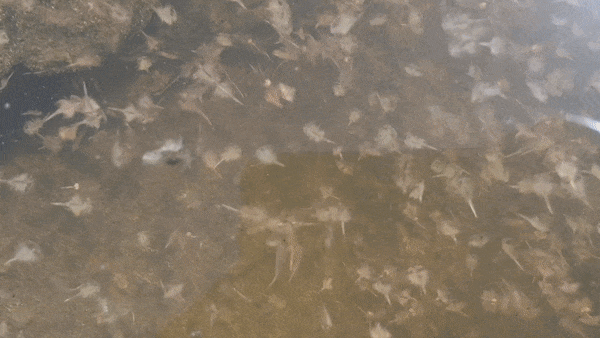Salt is an essential nutrient and an important ingredient in the food we eat. Not only does it enhance the flavors of the foods we eat, it also is beneficial by restoring the electrolyte and fluid imbalance in our bodies. These days though very few people complain about lack of salt in their diet, on the contrary it is quite the opposite.
But there are some arthropods whose primary care physicians warn them they need to be surrounded by more salt, not less. Enter "Brine Shrimp".
During my recent escapades participating in California Gull Surveys, I stumbled upon these salt evaporation ponds where the brine shrimp party was in full swing. These little fellas were having a blast, swimming around and probably doing synchronized swimming routines.
So, I had to do my duty of scooping them up to get a closer look to see what their deal was. Brine shrimp, except looking all cute and helpless, don't have much to fight predators other than their ability to live in bodies of water with salt concentration up to 10 times that of sea water.
Among this wild shrimp frenzy, I spotted a group playing the train game. I have no idea what the rules were, but they were seriously into it.
Before we look into why that group was playing the train game, let's learn some basic brine shrimp biology. Adult female brine shrimp can be recognized by their brood pouch which is used to carry and protect eggs during their development. It's like they're carrying a tiny daycare center with them everywhere they go.
Adult males can be identified by their handlebar mustache. These pair of appendages are called claspers and no, they are not for clasping a cold one while watching Saturday night football.
Instead, males will, as part of their courtship rituals, clasp on to the female's brood pouch for extended periods of time to mark their stake on the female. This behavior is called mate guarding. While clasping onto the female, the pair will keep swimming in tandem. This helps the female feed on more food thus providing nourishment to eggs that will be fertilized soon.
Another male I saw getting in the mood was the one shown below. The only strange part of this encounter is that the female was already deceased. You can tell the difference by comparing it to the scene above where each of the partners' legs are moving. I did not want to break his heart, so I let him do what gives him joy. Stop judging me or this male shrimp, life is tough already.
Once the female's eggs are fertilized, she's faced with a big decision. Will she go the live birth route or release dormant cysts? It's like choosing between instant gratification and long-term planning. If the tech industry is booming and crypto is hitting all-time highs, she'll opt for live birth, unleashing tiny swimming nauplii into the world. Observe the free-swimming nauplius below.
But if things aren't looking rosy, like if the current president failed to build a wall around AI technology thus causing the tech sector to cull workers like the chickens in a poultry farm once the avian flu is detected. Sensing no jobs and an impending sense of doom for its future generation, the female may decide to instead release a dormant cyst. These cysts can survive in the absence of water or food for 25 years until perfect conditions arise. Below are how the cysts look like. Look out for dark brown eggs that one of the nauplii is playing soccer with.
Btw, a portion of this post was scripted by AI. Credit where credit is due. Maybe next post I will let AI take the reins.











No comments:
Post a Comment
Did you learn something new in this post? Let us know in the comments below